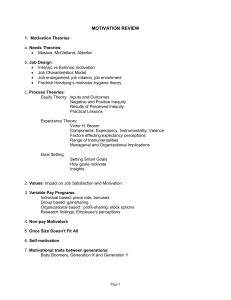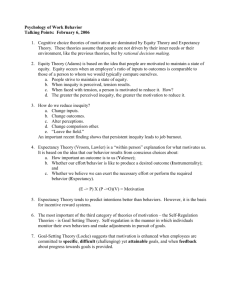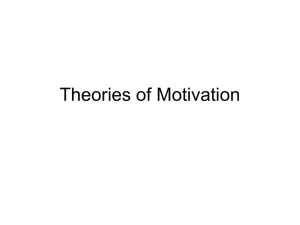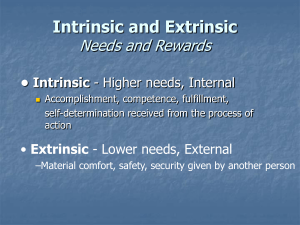1 Chapter 12 Work Motivation INP3004/MAN3360
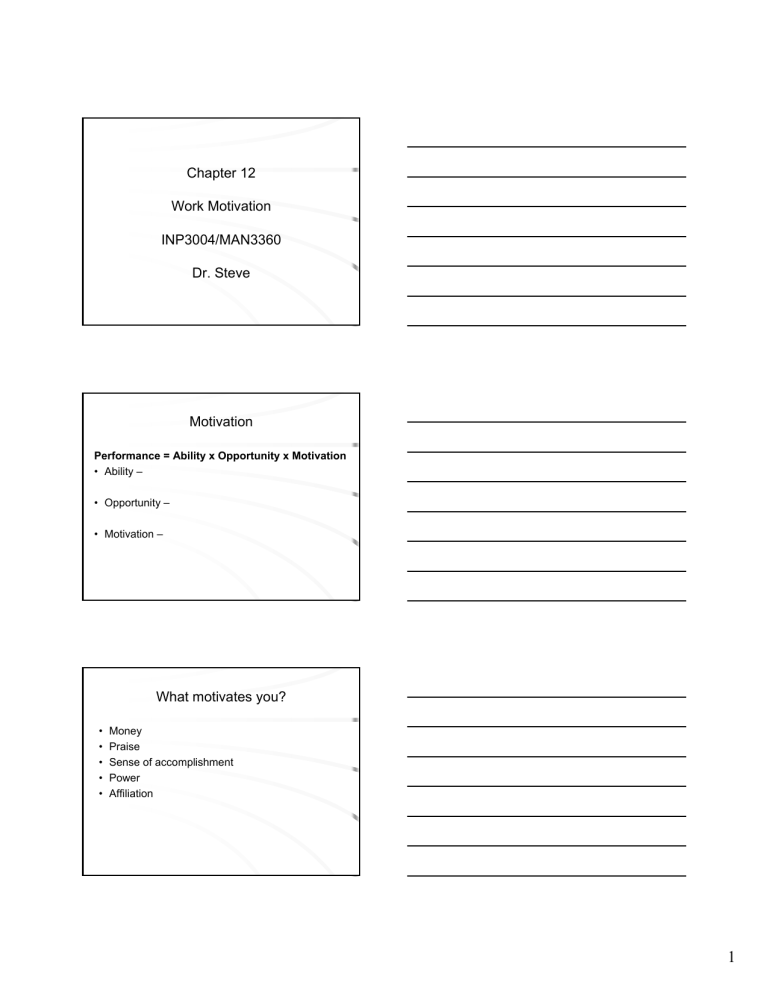
Chapter 12
Work Motivation
INP3004/MAN3360
Dr. Steve
Motivation
Performance = Ability x Opportunity x Motivation
• Ability –
• Opportunity –
• Motivation –
What motivates you?
• Money
• Praise
• Sense of accomplishment
• Power
• Affiliation
1
Theories of Motivation
Maslow’s Need Hierarchy Theory
• Behavior is determined by the lowest unmet need
• Spend our lives trying reach Self-Actualization
SA
Esteem
Social
Safety
Physiological
Maslow’s Need Hierarchy Theory
Critique
• Self-Actualization is poorly defined (measure?)
• Others proposed fewer levels of need
• Question whether needs must be met in order
• Little if any empirical support
• More descriptive of life than theory of motivation in the workplace
Theories of Motivation
Equity Theory
(Adams)
• Equity Theory –
• Inputs –
• Outcomes –
2
Self
20 / 20
20 / 10
20 / 20
20 / 40
Equity Theory
Other
20 / 20
40 / 20
20 / 40
20 / 20
Comparison
Fair – no inequity
Fair – no inequity
Unfair – underpaid
Unfair – overpaid
Equity Theory
How do you fix inequity? (How does inequity motivate us?)
• If overpaid hourly rate –
•If overpaid on piecemeal rate –
• If underpaid on hourly rate –
• If underpaid on piecemeal rate –
Equity Theory
Critique
• Some empirical evidence – individuals found to reduce effort when believed they were underpaid
• Other ways to fix inequity when perceive underpayment:
• Problems:
3
Theories of Motivation
Expectancy Theory
(Vroom)
• Effort Æ Performance Æ Reward Æ Goals
• Five Part model
1.
Job Outcomes (O) –
2.
Valence (V)–
• Example: Promotion = +10, Fired = -10, Transfer = -5
3.
Instrumentality (I) –
4.
Expectancy (E) –
5.
Force (F) –
• Force = E (
∑
V I)
Expectancy Theory
Example
Outcomes Valence Instrumentality Expectancy Force
Promotion
Raise
Transfer
10 .5
8 .1
.5
-5 0
Force = .5 [(10 x .5) + (8 x .1) + (-5 x 0)] = 2.9
Expectancy Theory
Validation
• Force = 2.9, So What?
• Correlate force score with other measure of effort to validate theory (e.g., hrs spent on job, peer ratings, etc.).
• Validate
– Between Subjects experiment –
– Within Subjects experiment –
• Results:
4
Expectancy Theory
Implications
• Placement vs. Selection
– Theory better predicts what tasks a person is most motivated to perform than who is most motivated
• Placement validities: .5 to .6
• Selection validities: .3 to .4
• How to make theory work for you (as a Mgr.):
Theories of Motivation
Reinforcement Theory (Skinner)
• Based on Thorndike’s “ Law of Effect ” –
• Skinner suggests not a theory at all, but a description of the cause of behaviors
– MOTIVATION?
• S
D
--- R Æ Sr+
• S
D
= Discriminative Stimulus – A
• R = Response – B
• Sr+ = Reinforcing Stimulus – C
Reinforcement Theory
Schedules of Reinforcement
• Fixed Interval –
– Scalloping response pattern
– Example –
• Fixed Ratio –
– Post-reinforcement pauses
– Example –
• Variable Interval –
• Fairly steady responding
– Example –
• Variable Ratio –
– Continuous, rapid responding
– Example –
5
400
Reinforcement Theory
Schedules of Reinforcement
Variable Ratio
Fixed Ratio
300
Variable Interval
Fixed Interval
200
100
0
0 5 10 15 20 25 30 35 40
Time (Minutes)
Reinforcement Theory
Which Schedules Work Best?
• Continuous reinforcement to acquire new skill
• Intermittent reinforcement to maintain skill
– Ratio better than Interval (more rapid responding)
– Variable better than fixed (higher resistance to extinction)
Theories of Motivation
Goal Setting Theory
• Goal Setting Theory –
• Goals help tell how much effort must be exerted
• Goals are most motivating when they are:
1.
2.
3.
4.
6
Goal Setting Theory
Experimental Results
100
90
80
70
60
50
Do your best
Specific hard goal
40
1 2 3 4 5 6 7 8
Blocks of four weeks
9 10 11 12
From Latham & Baldes (1975), “The Practical Significance of Locke’s Theory of Goal Setting,” Journal of Applied Psychology, 60, p.123
Job Characteristics Model
Five core job dimensions (Hackman & Oldham)
1. Skill Variety –
2. Task Identity –
3. Task Significance –
4. Autonomy –
5. Feedback –
Job Characteristics Model
Core Job
Dimensions
Critical
Psychological
States
Personal and
Work Outcomes
Skill Variety
Task Identity
Task Significance
Autonomy
Feedback
Experienced meaningfulness of work
Experienced responsibility for outcomes of work
Knowledge of actual results of work activities
Employee Growth Need Strength
High internal work motivation
High quality work performance
High satisfaction with work
Low absenteeism and turnover
7
Job Characteristics Model
Formula to determine motivating potential of job
Motivating
Potential Score =
(MPS)
Skill
Variety
+
Task
Identity
+
Task
Significance x Autonomy x Feedback
3
Comparison of Motivation Theories
Source of Motivation Empirical Support Industrial Applicability Theory
Need Theory
Equity Theory
Expectancy
Theory
Reinforcement
Theory
Goal Setting
Theory
Unconscious, innate needs
Drive to reduce feelings of tension caused by perceived inequity
Relationship among desired outcomes, performance-reward, and effort-performance variables
Schedule of reinforcement used to reward people for their performance
Intention to direct behavior in pursuit of acceptable goals
Weak: Little support for proposed relationships among needs
Very limited: Theory lacks sufficient specificity to guide behavior
Mixed: Good support for underpayment inequity, weak support for overpayment inequity
Moderate-strong: More strongly supported in withinsubject (placement) than between-subject (selection) experiments
Moderate: Ratio reinforcement schedules evoke superior performance compared to interval schedules, but little difference exists among various ratio schedules
Limited: Social comparisons are made, but feelings of inequity can be reduced through means other than increased motivation
Strong: Theory provides a rational basis for why people expend effort, although not all behavior is as consciously determined as postulated
Moderate: Contingent payment for performance is possible in some jobs, although ethical problems can be present in an organization’s attempt to shape employee behavior
Moderate-strong: Performance under goal-setting conditions usually superior to conditions under which no goals are set
Strong: Ability to set goals is not restricted to certain types of people or jobs
7 Things Needed to Motivate
Employees
1.
Ensure worker’s motives are appropriate for job
2.
Make jobs attractive and consistent with worker’s motives
3.
Define clear, challenging goals (goal setting)
4.
Provide necessary resources to do job (opportunity)
5.
Create social support systems (respectful environment)
6.
Use positive reinforcement for good performance
7.
Combine previous 6 into one system
Katzell and Thompson
8
